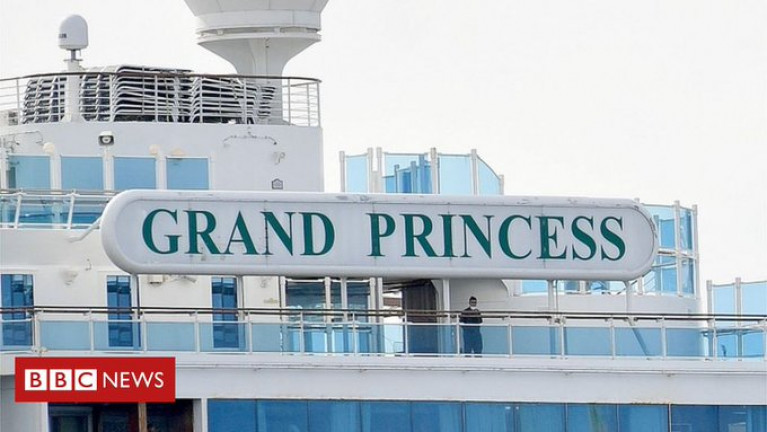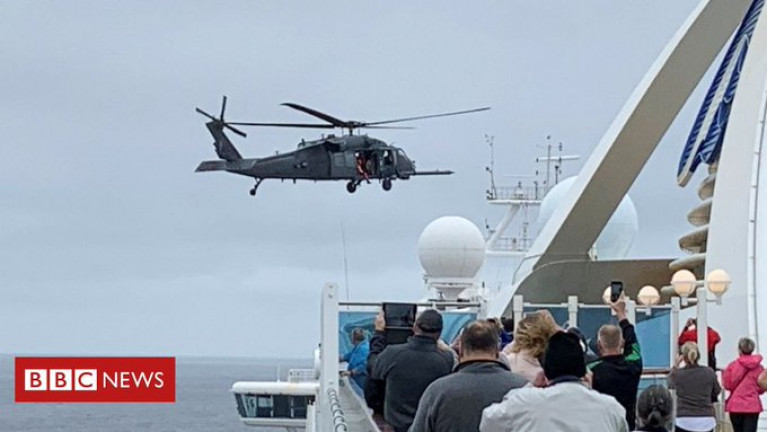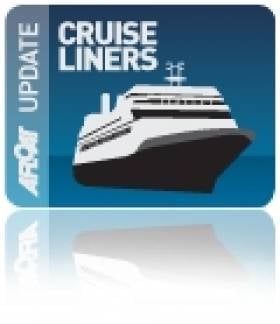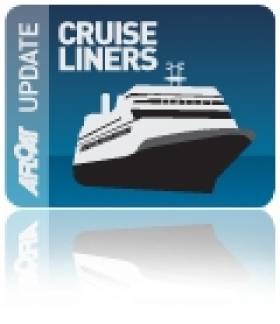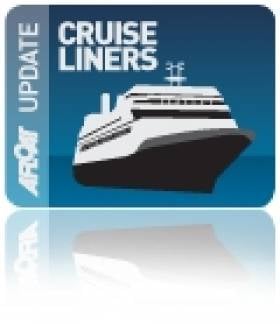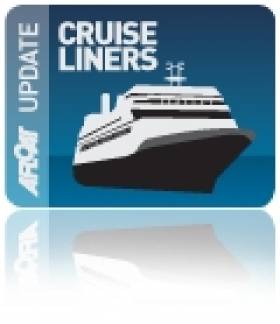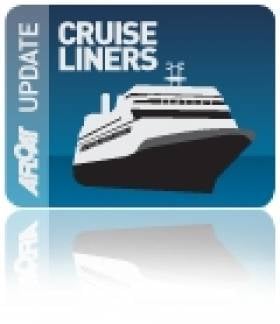Displaying items by tag: Grand Princess
In the US state of California, authorities are preparing to receive passengers aboard a virus-hit cruise liner held off San Francisco.
Nineteen crew members and two passengers, reports BBC News, on the Grand Princess have tested positive for Covid-19.
The vessel, which is carrying about 3,500 people from 54 countries, has docked in Oakland after five days stuck offshore.
The US has reported more than 560 coronavirus cases and 24 deaths.
Cases of the virus have been recorded in 34 states plus Washington DC.
For more click here.
In addition earlier today, RTÉ News understands there are a number of Irish citizens on board the Grand Princess and that one of the senior crew members is Irish.
Since BBC's coverage this evening an updated RTE story was posted.
A cruise ship flagged in the US is understood to be carrying a number of Irish citizens, as well as 21 confirmed coronavirus cases, has been given permission to dock, with its passengers to disembark in Oakland on Monday.
According to RTE News, nineteen crew members and two American passengers are confirmed as having the virus on board the Grand Princess - out of 45 people tested.
(Afloat adds last month a sister of the 'Grand' class cruise ship, Diamond Princess docked in Japan from where British and Irish passengers were evacuated to the UK for quarantine).
The department of Foreign Affairs has said the consulate in San Francisco is in touch with local authorities and monitoring the situation closely.
Authorities have ordered the vessel to remain at sea off the coast of San Francisco, where it was due to dock yesterday following a 14-day trip to Hawaii, after it emerged that a passenger on a previous voyage had contracted the virus and later died.
The vessel will instead go to nearby Oakland on Monday and begin disembarking passengers in need of "acute medical treatment," vessel owner Princess Cruises said in a statement.
The ship's crew will be quarantined and treated aboard the ship, the company added.
For more including details of another cruise ship effected by the outbreak and more click here.
Cruiseship on Atlantic Repositioning Cruise
#ATLANTIC REPOSITIONING CRUISE – Another massive cruiseship the Caribbean Princess (2004/112,894grt), is to dock in Dublin Port around lunchtime today, having crossed the Atlantic, from Halifax, Nova Scotia in Canada, writes Jehan Ashmore.
The 3,600 passenger capacity 'Grand' class ship operated by Princess Cruises is on a repositioning cruise voyage from North America to Europe. She is to spend the season running cruises based out of Southampton.
Caribbean Princess retains her 'Skywalkers' Nightclub mounted 15 decks at the stern, unlike her sister which called to Dublin Port last month. The structure was removed primarily on grounds of weight so to increase fuel efficiency.
The Bermuda flagged vessel is to berth at Ocean Pier in the centre of the docks which this season is to welcome a total of 90 cruiseships bringing 100,000 passengers contributing €35- €50m to the Dublin economy in 2012. It is estimated that the cruise sector has contributed over €350 million to the capital in the last decade.
Vessels such as the Caribbean Princess and larger-sized ships could be a familar sight closer to the city-centre should proposals to build a €30m dedicated cruise terminal take-off at a site adjacent to the East-Link Bridge, as part of the Dublin Port Company's Masterplan 2012-2040.
‘Lost Weight’ Cruiseship to Call to Dublin Port
#CRUISE LINERS – Following Friday's first cruise call to Dublin Port this year of the 300-plus passenger Arion as previously reported, the considerably larger Grand Princess is to call on Wednesday. Notably on this occasion the 2,600 passenger cruiseship is to appear without her signature 'Skywalker' Nightclub, which used to be perched 18 decks-high at the aft of the vessel, writes Jehan Ashmore.
The aptly named nightclub was built on two legs to form a bridge (see PHOTO) and was accessed by a glass gangway. Not only was the structure at such an elevated position but it also overhang beyond the sheer of the stern superstructure below, where clubbers had bird's eye views over the oceans and to numerous ports of calls.
In an operation to remove the Skywalker last year, the structure weighing 211 tons took over 10 hours to complete (as previously reported including VIDEO of the work). The reason for removing the nightclub according to her owners Princess Cruises was to 'significantly improve the operational performance of the ship, including greater fuel efficiency.' For a post dry-docking view click PHOTO.
During the procedure at the Grand Bahama Shipyard in the US, the opportunity included the installation of a new nightclub three decks below and was named One5.
Ironically before the vessel lost weight!....she was the first cruiseship to visit Dublin Port to surpass the 100,000 tonnes milestone, when the leadship of the 'Grand' class docked in 2004.
From Falmouth to the Fjords
#CRUISE LINERS – Dublin Port's first cruise caller for this season will be Arion which today sets sail from Falmouth on an eleven night / twelve day cruise to Scotland and Norwegian fjords. The 5,888 gross tonnes cruiseship built in 1965 is to berth in the capital at Ocean Pier, writes Jehan Ashmore.
The veteran vessel which has sleek traditional lines can carry over 300 passengers and she is operated by Classic International Cruises. Her visit will be one of around 90 cruise calls scheduled to Dublin Port during this year's season which stretches to early October. The majority of these calls will be in the summer and where several ships will be making repeat port of calls.
With so many callers to Dublin Port, this brings a greater variety of vessels as evident between the Arion and Princess Cruises considerably larger Grand Princess which is due next week. The giant vessel weighs over 109,000 gross tonnes and has a capacity for over 4,000 passenger and crew.
The Portuguese flagged Arion is also set to open the season to Galway, as previously reported she is to make an anchorage call off the mid-west harbour next month.
Meanwhile following all the recent focus centred in Cobh, Cruise & Maritime Voyages Marco Polo is expected to arrive this afternoon by berthing at the town's dedicated cruiseship quayside.
Cruiseships Great and Small Lineup for Dublin 2012
#CRUISE LINERS- Around 85 cruiseships are scheduled to call to Dublin Port in 2012, which compares closely to the same number of calls for this year's season, writes Jehan Ashmore.
First to start the season will be Grand Princess, which has the accolade of being the inaugural cruiseship to enter the port with a tonnage surpassing the 100,000 gross tonnes. The milestone was marked by the Princess Cruises call in 2004.
As usual with that number of cruise-callers, the variety of vessels will range from the small to the very large. A prime example is the diminutive expedition cruiseship Quest (1,180 tonnes) and at just under 50-metres long has just over the same number in passenger capacity.
In complete contrast to the ice-strenghtened Quest is the giant Caribbean Princess, a larger sister of Grand Princess, can accommodate over 3,000 passengers and she is make several calls.
Noble Caledonia which has been operating Quest (PHOTO) on successful seasons in Scotland, is to embark on itineraries next season to Ireland, England and Wales for the first time. Her half-sister Ocean Nova has called to Dublin on previous occasions.
For only the second time, Queen Elizabeth is due return to the capital (for report click HERE) in late Summer and in the same week, Hebridean Princess is also scheduled to call. The later vessel in recent years was chartered to Queen Elizabeth II, for a cruise off the Scottish Isles. To read more on the small ship's visit to the port earlier this year click HERE.
Cruiseships Head for Cobh in advance of Queen Elizabeth
The 2,500 passenger Jewel of the Seas has a nine-deck centrum which has glass lifts which allows light to flow throughout the spacious and airy ship. Activities range from golf to climbing, a spa and sumptuous restaurants.
When the 2004 built cruiseship docks at the dedicated cruise berth at Cobh in the early hours of tomorrow she will also be sharing the deepwater berth with the 2001 built Silver Whisper. The ultra-luxury vessel accommodates only 388 passengers and is operated by SilverSeas Cruises. To read more about the vessel click HERE.
Both vessels are scheduled to depart Cobh around teatime tomorrow and this will be followed by preparations of the picturesque town which is to welcome the maiden call to Cobh of Queen Elizabeth on Saturday. To read more about the newest vessel of the Cunard Line fleet click HERE. The 2010 built vessel will firstly make an inaugural call to Dublin on Friday prior to the Cobh call which coincides with Cork Harbour Open Day, for event details visit www.corkharbour.ie
A Former Royal is Set to Return
At 6,000 tonnes, the luxuriously appointed expedition cruiseship caters for only 132 guests. She is designed to explore remote waters and with an ice-strenghtened hull she can provide destinations that include the polar ice-caps. Shore-based excursions from the ship are taken by a fleet of Zodiac-craft to transport passengers to isolated locations.
Onboard the Bahama-flagged vessel, passenger can browse in the boutique, sip a drink in the internet café, enjoy a full-service spa, take a beauty treatment in the salon, get fit in the gym or take it easy in the sauna. Plus there's live-evening entertainment and not forgetting the two top-deck whirlpools.
For a vessel of this size her facilities are comparatively impressive to the large cruise giant's such as the Grand Princess. She became the first cruiseship to measure over 100,000 tonnes when she made an inaugural call to the capital in 2004.
Nearly 300m long the vessel is the equivalent in length to three football pitches. The ship may not actually feature a playing pitch though she does have a nine-hole putting golf course!
A floating crane-barge with a 1,000 ton lifting capacity hoisted the structure sky-high away from the ship which was berthed at the Grand Bahama Shipyard drydock facility. The ships owners, Princess Cruises cited the main reason for the removal was in order to 'significantly improve the operational performance of the ship, including greater fuel efficiency.'
Grand Princess may have lost her signature Skywalker Nightckub but three-decks below a new nightclub, One5, inspired by its Deck 15 location was created. In addition to this work which took place during April and May the 2,600 passenger cruisehip also underwent a major refit. The ship which had its last major refurbishment in 2004 has amenities to include an outdoor movie screen, fitness centre, spa, casino and four swimming pools.
For 'interactive' deckplans click here and interior slideshow click this link.
The distinctive 'Skywalker' feature became one of the most iconic in cruiseship naval architecture when the Grand Princess was launched as leadship
of the 'Grand' class in 1998. Located at the extreme aft of the vessel, the nightclub could only be reached by clubbers using an angled walkway (photo). Externally the feature was referred by some as the 'shopping trolley' and others percieved the design infleunce from towering poops found on ancient war-faring galleons.
Irrespective of the design origins, another 10 'Grand' class vessels were built by the Italian Fincantieni (at Malfalcone) Shipbuilding Group. The 'handle' (photo) feature on the Grand Princess was made with a heavier material compared to Golden Princess (2001) and Star Princess completed a year later. So there are no plans to remove these nightclubs. Of the more recent additions to the class modifications have appeared, notably without the inclusion of the Skywalker Nightclub's but there are changes to funnel designs.
Outside the Princess Cruises brand, the Ventura and Azura (also of the Grand-class) operate for P&O Cruises, serving the UK market from Southampton. The Hamsphire port welcomed the pioneering leadship Grand Princess on 5 May after she made a 16-day trans-Atlantic repositioning voyage from Port Everglades.
The cruiseship which has a crew of 1,200 alone will make the UK port its seasonal homeport this year from where she sails on cruises in Europe. On one of these cruises itineraries the Grand Princess (290m long x 36 beam X 8.5m draft) included a visit to the Port of Cork today. You can monitor the ship from Cobh Cruise Terminal via the 'live' bridge web-cam, noting the vessel is due to depart at 18.00 this evening bound for Dublin Port.
Grand Princess became the first cruiseship to measure over 100,000 gross registered tonnes when the 108,806 (grt) vessel docked in Dublin on 31 August 2004.
Last year the port handled 88 cruisecalls and this number of vessels is to be closely repeated this season. Over 200 cruise calls with around half a million passengers and crew are scheduled to visit the island of Ireland. The cruise sector business is estimated to generate €60m to the economies
north and south.
Cruise-Callers Set to Start Summer Season
Dublin Port last year had 88 cruisecalls and this number of vessels is to be closely repeated in 2011. One of the calls will be Princess Cruises 3,100 passenger Grand Princess. This was the first cruiseship of over 100,000grt to dock at Dublin which arrived on 31 August 2004 (click for photo on the day) and to read more about the cruiseship industry in Ireland from the IMDO click here.
Outside the capital the following vessels outlined are the first cruiseships to call at other ports in April. The season runs to September, though in recent years occasional calls are still made up to November.
The first cruise-caller at Waterford is Quark Expeditions adventure exploration vessel Ocean Nova. At only 2,118 tonnes the diminutive vessel is only 73m long and equally has the same number of passengers and a crew of 38.
Built in 1992 the polar adventure vessel has an ice-strengthened hull to enable the exploration of the icy waters of Greenland, the Weddell Sea and the Antarctic. A pair of Zodiac craft are provided for shore-landings.
The hosting of the Waterford Tall Ships Race Festival has led to funding of €1.7m from Failte Ireland to upgrade the city-centre's Frank Cassin Wharf. This will allow the large 'A' class tallships to berth and will be a lasting legacy of the festival. The wharf will then be used to berth cruiseships and other marine users. In total the crystal city is to welcome 12 callers to include the Crystal Serenity in July.
Cork is set to welcome 54 cruisecalls to include the return of the Cunard Line's 90,000grt Queen Victoria which made her first call to Cobh last year. The 2007 built vessel has a guest capacity for 2,000. The Cunard flagship Queen Mary is scheduled mid-September.
The deepwater berth at Cobh Cruise Terminal is capable of handling some of the largest cruiseships and which will see the return of the 122,000grt Celebrity Eclipse also in April.
Celebrity Eclipse made her maiden cruise and port of call to Cobh last year following her high profile repatriation voyage from Spain with stranded UK tourists arising from the fallout of the Icelandic volcanic ash-cloud. The 2,850 passenger €500m cruiseship which made an overnight call at Cobh during the May Bank holiday weekend.
From the south to the north at Belfast, the port's first caller on 24 April is the Ocean Nova which makes another appearance on the Irish cruiseship scene.
Belfast Harbour Commissioners have developed the 1km long Stormont Wharf to attract increasingly larger cruiseships to the city. The Ocean Nova's visit will mark over a dozen years since the first cruiseship docked in the northern capital.
In 2011 Belfast is scheduled to accommodate 30 cruise-calls bringing over 50,000 passengers to the city and surrounding environs.



























